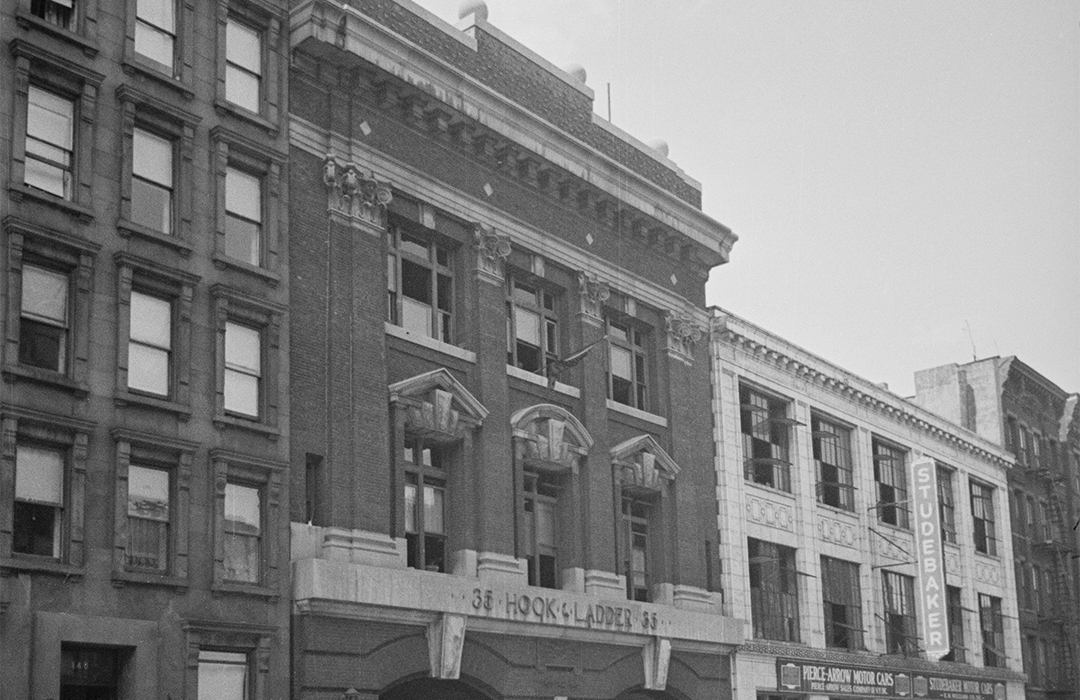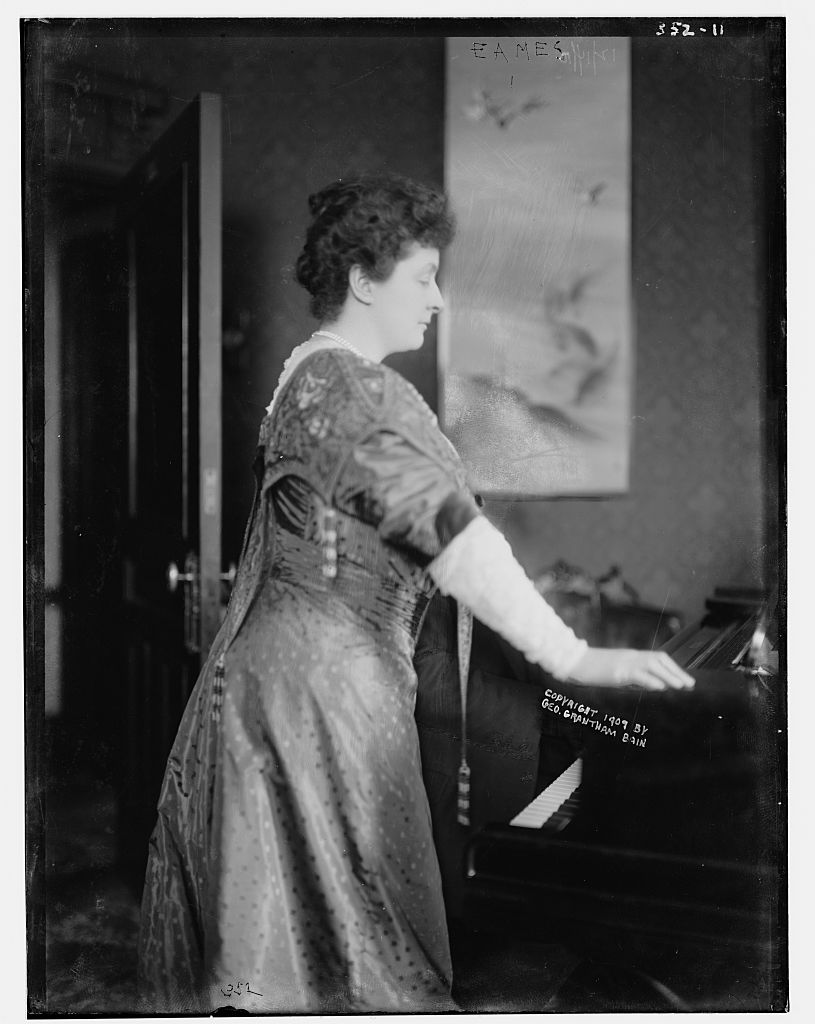
142-144 West 63rd Street – Hook & Ladder Co. 35
by Tom Miller
On January 3, 1906, the New-York Tribune reported that the architectural firm of Werner & Windolph had filed plans “for a three story house to be built at Nos. 142 and 144 West 63d-st., for the new Hook and Ladder Company No. 20.” The article (which got the number of the company wrong) noted that the 50-foot-wide firehouse would have “a façade of brick and trimmings of limestone. It will cost $60,000.” That figure would translate to about $2 million in 2024. In fact, the station was intended for the newly formed Hook & Ladder Company 35.
Construction was completed before the year’s end. The architects’ Beaux Arts design typified the stations being erected throughout the city. Two gaping engine bays flanked a pedestrian doorway. A limestone intermediate cornice introduced the two-story upper section, where each bay was separated by brick pilasters capped with limestone capitals. A stepped parapet crowned the prominent stone cornice.
The bravery of firefighters is regularly called into action. On December 26, 1907, Hook & Ladder Co. 35 responded to a blaze in a house at 19 East 134th Street. Seeing a woman and her baby trapped on the top floor, firefighter George L. McKenna rushed into the blazing residence. The New York Times reported, “He carried her from the fifth floor of the house, which was on fire from top to bottom, with her baby in her arms.” Mayor George McClellan McKenna later awarded McKenna the Strong Medal for bravery.
Renowned soprano Emma Eames sang at the Firemen’s Memorial benefit in the Metropolitan Opera House on May 1, 1908
Renowned soprano Emma Eames sang at the Firemen’s Memorial benefit in the Metropolitan Opera House on May 1, 1908. Afterward, she commented to Chief Edward Croker “that she had always wanted really to know some of the smoke eaters,” reported The Sun. Croker was more than willing to fulfill her wish. He escorted her to several fire stations on May 4, “and all along the line a lot of very proud and blushing firemen did their best stunts to win the singer’s approval,” said The Sun. When they arrived at Hook & Ladder Company 35, Battalion Chief McKiernan had the men bring out the extension ladders “and [they] showed the visitor how rescues are made,” said the article. “Mme. Eames held her breath while the men ran up the swaying ladders.”
Somewhat disappointingly for the firefighters, it wasn’t their acts of bravado that impressed the soprano. “Her greatest interest was in the bull pup mascot of the company. She had heard how the dog had saved a family of puppies at a recent fire, and she made so much of the mascot that he was voted a mighty lucky bowlegged pup.”
At a time when stables were filled with hay, houses were illuminated by flammable gas, and tenements were often ramshackle firetraps, Manhattan firefighters regularly dealt with difficult blazes. Underground railroads brought a new challenge. On January 5, 1915, a fire broke out within the subway under Broadway. The Evening Post reported, “hundreds of subway passengers…made their way through the smoke and darkness to the little platform beneath the grating at 55th Street and Broadway, and were lifted, and dragged from there to the open air.” But not all the passengers were able to escape on their own. Firefighter Charles Goldstein described the conditions, saying, “It was thick and choking smoke down there, and I could hardly see a foot ahead of me. People were shrieking, and there was the wildest excitement.” He helped passengers up the emergency ladder at 55th Street, then went back into the tunnels to search for other victims. From his hospital bed, he explained:
I looked into the stalled trains and saw passengers sitting in their seats erect, overcome by the dense smoke before they could make a move to get out. I took up the ladder about a dozen people, and then reeled over myself, overcome. The boys pulled me out and brought me to. Then I went down into the subway again and took out more people. But I was not quite myself, and I choked with smoke again. This time they bundled me off here to the hospital, and I guess I’m all in.”
Tragically, the men were just seconds too late in arriving at a fire in the Santa Monica apartments at 345 West 70th Street on March 12, 1917. Camille Piedmont was described by The Sun as “a young French maid” who had been hired by Mrs. D. Harvey Middleton a few days earlier. Early that morning, Mrs. Middleton awoke to the smell of smoke in her fourth-floor apartment. She rushed to Camille’s room, woke her, and the two started out. The Sun reported, “it is supposed that the maid thought of something of value she had left behind and returned to get it.” Unfamiliar with her surroundings, she became disoriented, then trapped. As the flames spread into the apartment, she edged to the window, “where her screams caught the attention of Thomas Dalton and Christopher Carley” who worked in the garage across the street. Dalton ran to the fire alarm box while Carley shouted to the girl not to leap. With the heat of the flames intensifying, Camille Piedmont lowered herself out the fourth-floor window and hung by her fingertips from the sill.
On January 5, 1915, a fire broke out within the subway under Broadway.
“Carley, his hands to his mouth, continued telling the girl not to drop, while the crowd breathlessly watched the spectacle,” said the article. “A sigh of relief went up as the hook and ladder truck appeared, but this changed to a cry of horror as the girl dropped to the areaway.” The newspaper lamented, “One minute more probably would have sufficed to save her, as Hook and Laddery Company 35 was dashing up the street.”
A massive fire broke out in 21, 23 and 25 West 64th Street on the night of May 10, 1920. Four companies, including Hook & Ladder No. 35, joined forced to battle the blaze. John Gleason was among the firefighters on the roof when a back draught blew six of them, including Gleason, to the sidewalk. A total of nine firefighters ended up in the hospital that night, and, miraculously, none died.
Much less fortunate was firefighter John J. Jakoby. On November 5, 1938, the company was fighting a blaze at 442 West 57th Street when he fell through a shaft to his death. On June 7, 1939, Mayor Fiorello LaGuardia presented medals for heroism at the World’s Fair, including a posthumous award that went to Jakoby’s widow.
In 1959 ground was broken for the Lincoln Center for the Performing Arts. Its construction meant the demolition of scores of buildings, including the 1906 Hook & Ladder Company 35.
Tom Miller is a social historian and blogger at daytoninmanhattan.blogspot.com



